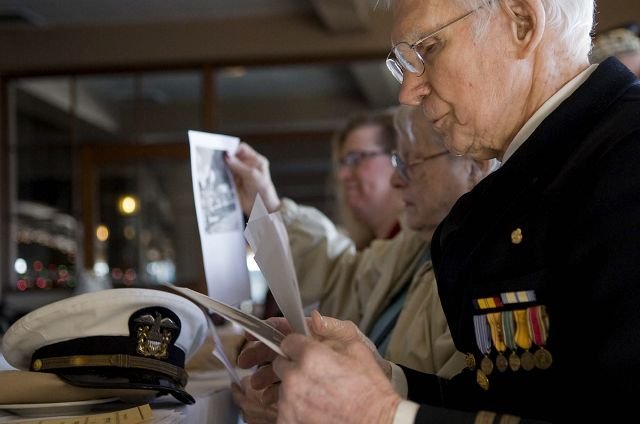Sixteen U.S. Navy ships have been named after individual sailors to commemorate their bravery at Pearl Harbor. The USS Ross, a guided missile destroyer, was named after the father of Vancouver resident Penny Hoffman.
Remembering Pearl Harbor: that’s what brought four survivors together Monday to observe the 68th anniversary of the Dec. 7, 1941, attack.
Bernard DeGrave also took time to recall Dec. 13. It was six days after the attack, but that’s when he realized the damage inflicted on the U.S. fleet by Japanese bombs and torpedoes.
His ship hurried out on patrol less than three hours after the first bombs fell.
Pearl Harbor was so choked with smoke that DeGrave couldn’t get a sense of the massive destruction as his ship headed out to sea.
“You don’t see the whole picture,” he said.
When DeGrave and his shipmates ship steamed back into Pearl Harbor on Dec. 13, “We were flabbergasted at the extent of the damage,” he said.
“That’s when it hit us, when we saw our ships mangled and wrecked,” the Vancouver veteran said in a riverside banquet room Monday morning.
DeGrave, John Bruening, Paul Johnson and Larry Lydon were joined by friends and family members Monday for the annual Dec. 7 memorial held by the local chapter of the Pearl Harbor Survivors Association.
Fellow member George Bennett was scheduled to be at Pearl Harbor for two commemorative events Monday.
Bennett was a member of a U.S. Navy seaplane squadron based on Ford Island.
Bruening was a soldier in the Army’s 24th Infantry Division, based at Schofield Barracks.
Johnson was a gunner’s mate on the USS Castor, a supply ship loaded with 10,000 tons of ammunition.
Lydon was an officer on the USS San Francisco, a heavy cruiser scheduled to go into dry dock for maintenance.
DeGrave was a radioman on the USS Montgomery, a World War I-vintage destroyer that had been converted into a mine-laying ship. It was among three ships berthed near Pearl City when the Japanese attacked.
“We weathered it just fine,” DeGrave said. “All the planes went right over the top of us.”
His assigned combat station was at a 4-inch gun, but “that was useless as an antiaircraft gun,” he said.
“They needed people to supply the .50-caliber machine guns, so I volunteered to pass ammunition.”
DeGrave was down in the ship’s magazine, relaying ammunition, when he considered what might happen if a stray bomb or shell found its way down the hatch. He recalled thinking: “Gee! That was stupid!”
But the Japanese attackers had their sights on bigger ships, he said.
According to the report available on a Navy Web site (www.history.navy.mil), the ship’s commander reported hearing explosions at 8 a.m. and had the Montgomery heading out on patrol at 10:17 a.m.
After six days on anti-submarine duty, DeGrave’s ship returned to Pearl Harbor on Dec. 13, according to the report.
That’s when DeGrave and his shipmates saw the extent of the damage.
“We had so much faith in those big battleships,” he said. “And then to see them as scrap metal.
“We had nothing bigger to stop the Japanese navy than that little destroyer we were on,” he said. “We wouldn’t have been much opposition.”
But, as the former sailor had indicated, no one person could see the whole picture.
Retired Navy Cmdr. Lawrence Patella, the master of ceremonies at Monday’s memorial event, noted that some crucial resources survived the attack.
They included aircraft carriers and a battleship that were not at Pearl Harbor.
But mostly, it was the people who shook off that opening blow of the war and carried the fight to the enemy.
“The country could not have had a more patriotic group,” Patella said of the Pearl Harbor survivors.
“They served in battle,” Patella said “and then helped former enemies reconstruct their countries.”



